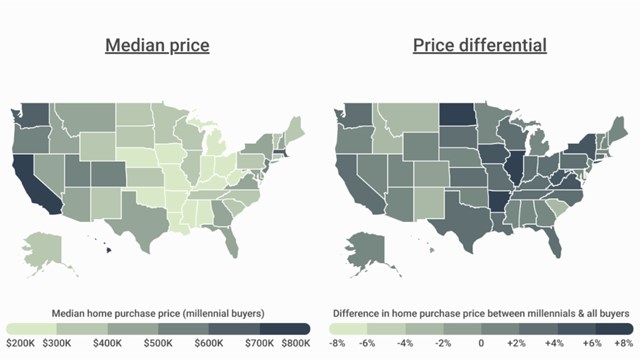The past few years have seen a dramatic swing from the red-hot market for condos and co-ops nationwide to the more challenging conditions markets around the country are experiencing today. Some of the underlying factors for this shift are buried in pre-pandemic policy changes; others are a direct product of economic pressures resulting both from the pandemic and from measures taken to combat its economic effects. Both have come together in what might be described as a perfect storm. Additionally, while these effects may have varied from state to state and displayed different outcomes for some time—in essence, positive in some locations and negative in others—they have now come together as mostly a pall over the market nationally.
The Big Picture
During the pandemic, housing sales took off nationally, with substantial movement of homeowners from urban locations into suburbs, from snowbelt to sunbelt. Prices for new homes, condos, co-ops, and even rentals reached new highs. Much of that growth in sales and prices was a result of low interest rates and infusions of cash into the public’s hands by government assistance programs meant to keep the economy moving while the pandemic kept us at home. One result was that much of existing and new inventory was absorbed, leading to much less available product going forward—compounded by construction slowdowns due to both supply-chain disruptions and pandemic work rules and requirements.
In early 2022, toward the end of the pandemic, the first substantive inflationary spike became evident. To control and ultimately tame the worst inflation in 40 years, the Federal Reserve chose a path toward higher interest rates—and nothing says ‘party’s over’ to homebuyers like a doubling (or more) of interest rates.
To take a deeper dive into where we are and where we are going, CooperatorNews has asked Jonathan Miller, President and CEO of national real estate appraisal and consulting firm Miller Samuel Inc. and author of the Douglas Elliman Market Reports for his take on the subject. Our conversation below has been lightly edited for clarity and space.
CooperatorNews: What trends existed in 2024 that affected coop and condo prices in NYC? What factors contributed to current market conditions and are those factors expected to continue affecting the market?
Jonathan Miller: “The spike in mortgage rates that began in early 2022 affected markets throughout the country. Sales slowed to levels that were 10 to 20 percent below long-term norms. Interestingly, there was little impact on prices, overall. They were a little softer than previously, but not by much. The frenzy of sales activity that occurred previously stripping many markets and regions of inventory slowed. The way we must think of housing prices in the wake of the pandemic, the biggest boom in decades, is to call it a lackluster market. Sales are slow, plain and simple. A big part of this is driven by the spike in interest rates, which have more than doubled in three years. Yet again, prices haven’t changed. One could argue that prices are off by single digit percentages, and that’s a function of inventory. When you think about the housing market today, it’s very repetitive nationally.
“In essence and with hindsight, what we have today—and it’s an interesting phenomena—is a housing market in which prices have essentially ranged from moving sideways to increasing because the Federal Reserve kept interest rates too low for too long.
“Normally what happens in a sales downturn is that there is a negative event that changes the market. In this case, that was the dramatic increase in mortgage rates. Normally when we see a surge in mortgage rates, we expect sales to slow and inventory to skyrocket, which it didn’t. And normally, sales prices fall sharply. That also did not happen. At the end of 2023, in a period of rising mortgage rates, I said that 2024 would be the year of disappointment because of low sales. Given the same question now, at the end of 2024, I say 2025 will be a year of less disappointment. Additionally, I’m suggesting we are probably going to see even higher rates in 2025, with an uptick in activity and seeing pricing move a little bit higher.”
CN: What factors were specific to the condo and co-op markets? Are there differing circumstances in different segments of those markets? Why? What do you project for shared community sales this coming year?
JM: “We do see differences in different segments of the market. Sales are more brisk at the high end of the condo market. When we look at the picture overall, the co-op market remains lackluster in terms of weaker sales activity relative to condos. That’s largely because co-ops are as a market lower priced than condos. The lower they are in price on the price spectrum, the more those units depend on and are sensitive to mortgage rates.
“As a general rule, we see more cash buyers in the condo market than the co-op market. Those buyers therefore bypass the restraints of higher mortgage rates. The other aspect is that we are clearly seeing a little bit more strength in activity as you move up in price. Part of that is generally that condos are higher priced, but it’s not a dramatic difference between segments of the market. It’s very subtle. One of the reasons why it’s more subtle is that buyers have been waiting for three years for rates to come down. With the outcome of the election and potentially greater inflationary policies in the new administration, particularly based on tariffs, participants in both markets aren’t expecting rates to come down.
“We do expect that the co-op market will be more challenged than the condo market. Co-ops are the point of entry for many first-time buyers, and are very rate-dependent. Expectations are that the Federal Reserve will make one more cut of 25 basis points. After that, it’s unlikely we will see much more cutting for a long while. The high cost of borrowing puts a premium on buyers who are all-cash over those who require mortgages.
“In the New York City co-op market specifically, at the end of third quarter 2024, cash buyers represented 47.9 percent of purchasers, and in the condo market that was 65.9 percent all-cash buyers. Clearly, condo buyers have greater ability to work around the rate problem.”
CN: What about levels of uncertainty due the election?
JM: “As concerns the election, I’ve looked at this. A few months ago, The New York Times published a study I did looking at four markets nationally. What we found was that during election years—federal election years, those even years when we have a presidential or congressional election—we found a slowdown of three to five percent, no matter which party, candidate, etc., ran or was elected. Immediately after, there’s a release, and the market catches up in three to four months. These slowdowns and pick-ups had no real impact on pricing, though. I expect this year to be the same.
“This past cycle though, there was a potential for misinformation and misperception to play a role, but fundamentally I don’t believe the market was impacted in real terms.
“Beginning in July there was a big jump in contract activity. That was before the Federal Reserve cut rates in September. The way to think of that event, even before the Fed cut rates, is that it was just a surge in getting back to zero. No real growth here. The other component in that equation is the idea that consumers have been waiting for rates to come down, which would energize the market. But, as I said before, that’s a long time to wait in the real world. Think of it this way: a young couple has triplets in a one bedroom apartment. At some point, people stop waiting—and that’s what we have seen in the past four to five months. Buyers are getting used to the rate environment.
“In my opinion, the low rate environment wasn’t good for the market. It made housing more expensive than it should have been. Overall, the result was a decimated inventory. The low rates caused an unrealistic environment. Therefore, in predicting what’s coming, inventory is the most important metric today. I think the normalization of inventory will take five years or more.”
CN: What do you see in 2025?
JM: “I would suggest that if we assume that mortgage rates don’t change dramatically, both co-ops and condos will see more transactions than they saw in 2024. Both have flat-to-rising prices, but nevertheless condos will sell better than co-ops. To make another general statement, I also think the higher-end market is generally poised for higher prices than middle and entry level. In New York, where co-ops are more commonly found than in other markets, higher-end condos have more upside than higher-end co-ops, because condos as a form of housing stock have significantly challenged the co-op market share. The top end of the co-op has been crushed by new condos.”
Our many thanks to Jonathan Miller for his insight; CooperatorNews will be following up in the coming months as 2025 unfolds.










Leave a Comment